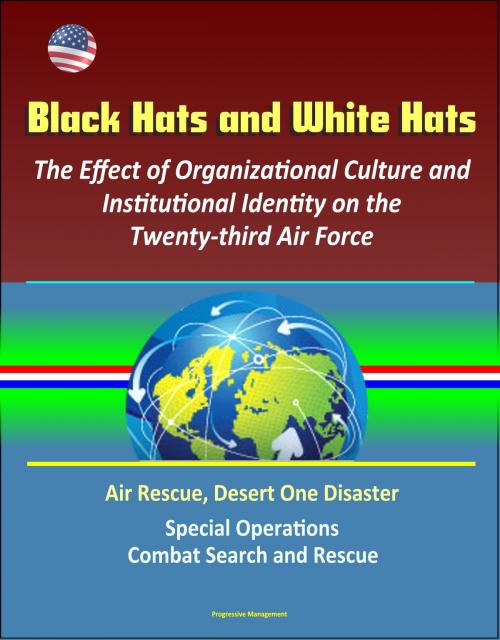Black Hats and White Hats: The Effect of Organizational Culture and Institutional Identity on the Twenty-third Air Force: Air Rescue, Desert One Disaster, Special Operations, Combat Search and Rescue
Nonfiction, History, Military, Aviation| Author: | Progressive Management | ISBN: | 9781370927685 |
| Publisher: | Progressive Management | Publication: | September 6, 2016 |
| Imprint: | Smashwords Edition | Language: | English |
| Author: | Progressive Management |
| ISBN: | 9781370927685 |
| Publisher: | Progressive Management |
| Publication: | September 6, 2016 |
| Imprint: | Smashwords Edition |
| Language: | English |
This excellent report has been professionally converted for accurate flowing-text e-book format reproduction.
On 1 March 1983, the United States Air Force activated the Twenty-third Air Force to consolidate the Air Force Special Operations Forces (AFSOF) and the Air Rescue and Recovery Service (ARRS). The Twenty-third Air Force's stewardship of AFSOF and rescue forces lasted until 1989, when the Military Airlift Command separated the two communities. Although brief, the Twenty-third Air Force's experience provides sufficient data for a thorough analysis of the effect of organizational culture and institutional agendas on the evolution of a nascent organization. The basic hypothesis explored in this paper is that organizational culture and institutional agendas significantly affected the rise and fall of the Twenty-third Air Force. The significance of this research effort is clear considering the 1 October 2003 merger of Combat Search and Rescue (CSAR) and AFSOF under the aegis of the Air Force Special Operations Command (AFSOC). In light of recent events, this study's ultimate goal is to provide a preview of how culture may affect AFSOC's endeavors to strengthen CSAR capabilities. By studying the past, this paper looks for glimpses into the future.
CHAPTER 1 - INTRODUCTION * CHAPTER 2 - UNDERSTANDING ORGANIZATIONAL CULTURE * CHAPTER 3 - HERITAGE AND CULTURE OF AIR FORCE SPECIAL OPERATIONS FORCES * CHAPTER 4 - HERITAGE AND CULTURE OF AIR RESCUE * CHAPTER 5 - ORGANIZATIONAL CHANGE: THE RISE OF THE TWENTY-THIRD AIR FORCE * CHAPTER 6 - ORGANIZATIONAL CHANGE: THE FALL OF THE TWENTY-THIRD AIR FORCE * CHAPTER 7 - FROM THE PAST, THE FUTURE * APPENDIX
DESERT ONE ANALYSIS
This excellent report has been professionally converted for accurate flowing-text e-book format reproduction.
On 1 March 1983, the United States Air Force activated the Twenty-third Air Force to consolidate the Air Force Special Operations Forces (AFSOF) and the Air Rescue and Recovery Service (ARRS). The Twenty-third Air Force's stewardship of AFSOF and rescue forces lasted until 1989, when the Military Airlift Command separated the two communities. Although brief, the Twenty-third Air Force's experience provides sufficient data for a thorough analysis of the effect of organizational culture and institutional agendas on the evolution of a nascent organization. The basic hypothesis explored in this paper is that organizational culture and institutional agendas significantly affected the rise and fall of the Twenty-third Air Force. The significance of this research effort is clear considering the 1 October 2003 merger of Combat Search and Rescue (CSAR) and AFSOF under the aegis of the Air Force Special Operations Command (AFSOC). In light of recent events, this study's ultimate goal is to provide a preview of how culture may affect AFSOC's endeavors to strengthen CSAR capabilities. By studying the past, this paper looks for glimpses into the future.
CHAPTER 1 - INTRODUCTION * CHAPTER 2 - UNDERSTANDING ORGANIZATIONAL CULTURE * CHAPTER 3 - HERITAGE AND CULTURE OF AIR FORCE SPECIAL OPERATIONS FORCES * CHAPTER 4 - HERITAGE AND CULTURE OF AIR RESCUE * CHAPTER 5 - ORGANIZATIONAL CHANGE: THE RISE OF THE TWENTY-THIRD AIR FORCE * CHAPTER 6 - ORGANIZATIONAL CHANGE: THE FALL OF THE TWENTY-THIRD AIR FORCE * CHAPTER 7 - FROM THE PAST, THE FUTURE * APPENDIX
DESERT ONE ANALYSIS















